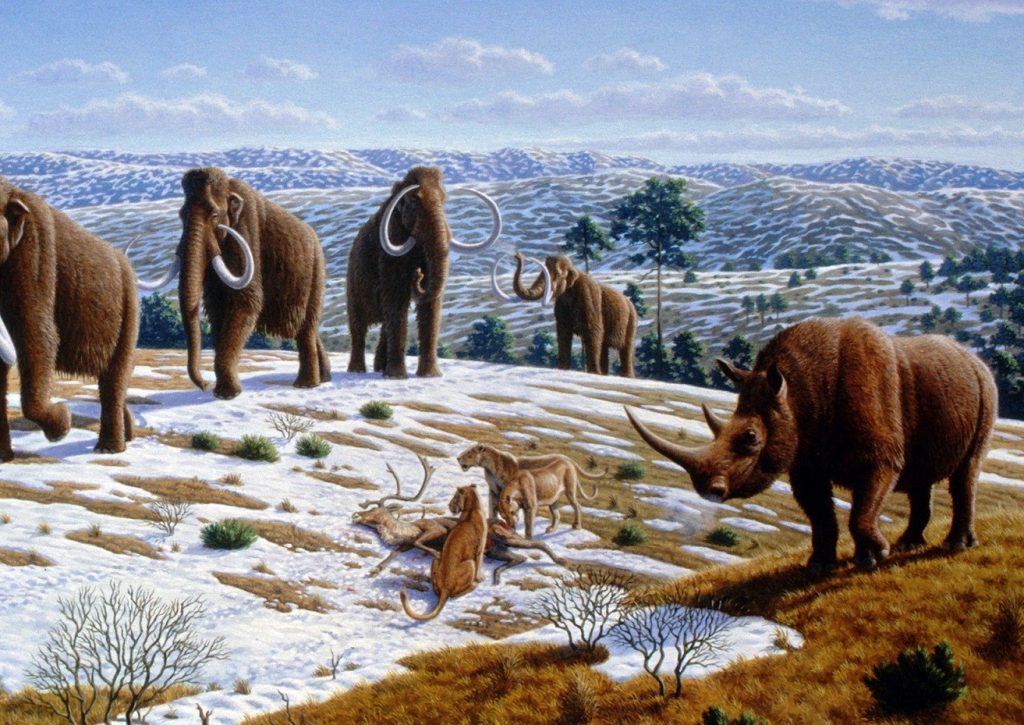
I was driving home from school, late at night. Paul Kennedy, the host of Ideas on CBC Radio, was intently discussing something. I wasn’t really paying attention, but suddenly I heard Paul Kennedy talk about bringing mammoths back to life. This got my attention. The thought of recreating extinct animals made me excited and nervous at the same time. As soon as I got home I found myself scouring through the internet for more information on this fascinating idea. My research brought me to the story and the science of de-extinction.
De-extinction is the belief that extinct species can be brought back to life. Beth Shapiro, professor at University of California, summarizes three ways scientists have tried to accomplish this: back breeding, cloning, and genetic engineering. Back breeding takes generations. In this method scientists try to resurrect ancestral traits that still persist within a population through selective breeding. Much faster are the processes of cloning and genetic engineering. Cloning creates genetically identical copies of extinct species from preserved cells. The cloned cells are then fused with the eggs of closely related species. Genetic engineering, on the other hand, edits the genome sequence in cells of living animals to resemble the genome sequence of an extinct specie. The edited cell is then fused with an egg of a related specie leading to the reprogramming of the cell.
The summary of the above methods should alert your attention to one crucial point: de-extinction is not really bringing back extinct species but a close approximation of extinct species. Cloning and genetic engineering can create similar or identical cells and DNA but we lack the extinct environments that interacted with the genes. Internally, we do not have the uterus of an extinct animal and externally, we do not have the physical environment, both of which are important in influencing the expression of genes and the behaviour of animals.
Then what exactly is de-extinction doing?
De-extinction is actually creating a new specie. Now, this should perk the interest of all IP law students. A new specie created by humans immediately produces questions about patents. Can these de-extinct species be patented? In Canada, the answer is a little complex.
In 2002 the Supreme Court of Canada ruled in Harvard College v Canada that higher life forms (in this case, a genetically engineered mouse) could not be patented. Yet, according to Norman Siebrasse, while higher life forms are technically not patentable, a “transgenic non-human mammal cell” with specified genetic characteristics could be. By protecting the patent of the cell, you are indirectly protecting the patent of the whole animal. Monsanto was afforded patent protection to genetically engineered canola and the Supreme Court of Canada affirmed that the protection of engineered plant cells provides you protection to the plant itself. According to Norman Siebrasse, this same guise can be used for genetically engineered animals. It should be noted that engineering of the plant has been legislatively protected under the Plant Breeders’ Rights Act. Regarding animals, as the law currently stands, the Court in Harvard College v Canada has ruled higher-life forms (like our de-extinct animals) are not patentable.
The question that then follows is: should species created through de-extinction be patented?
Many scientists advocate de-extinction as a conservation effort to right human wrongs. Humans caused the extinction of many species, and humans should be able to bring them back. Hendrik Poinar, an evolutionary biologist, provides a pessimistic view. His nightmare is that these new species will be placed in zoos for gawking crowds or even if free, they will be hunted down as prized possessions. Patents, if allowed, can promote this nightmare or protect against it, depending on who gets the patents.
Aside from the law, the process of de-extinction itself raises a host of concerns. Will these new species create unforeseeable impacts on the environment? Will these species cause the extinction of other species? Will this process cause harm to the de-extinct animal itself? In 2003, a bucardo was brought back from extinction, only to die a painful death within minutes. Then there is the old, highly debated question: should humans be playing God?
Michael Archer, a paleontologist at the University of New Wales, had once commented, “I think we played God when we exterminated these animals.” The recent death of the last male northern white rhinoceros is a sober reminder of this. War, habitat loss and poaching for rhino horns has left the northern white rhinoceros with only two females. Conservationists hope current innovative artificial reproductive techniques can prevent complete extermination. Some scientists say that science or “playing God” is the only hope we have.
